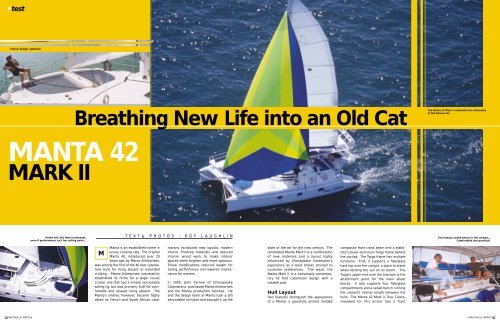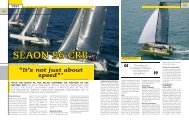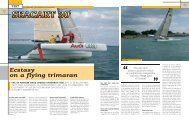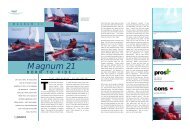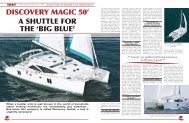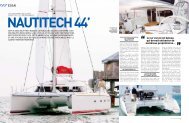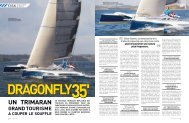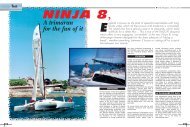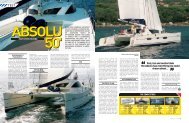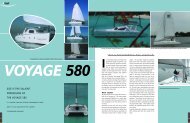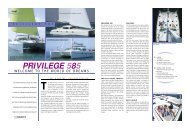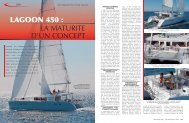52-55 - MANTA TEST US - Multihulls World
52-55 - MANTA TEST US - Multihulls World
52-55 - MANTA TEST US - Multihulls World
Create successful ePaper yourself
Turn your PDF publications into a flip-book with our unique Google optimized e-Paper software.
?test<br />
Classic design, updated!<br />
Breathing New Life into an Old Cat<br />
The Manta 42 Mark II maintains the silhouette<br />
of the famous 40...<br />
<strong>MANTA</strong> 42<br />
MARK II<br />
Under sail, this boat is pleasant,<br />
even if performance isn’t her selling point…<br />
TEXT& PHOTOS :<br />
ROY LAUGHLIN<br />
The famous raised bench in the cockpit…<br />
Comfortable and practical!<br />
Manta is an established name in<br />
luxury cruising cats. The original<br />
M<br />
Manta 40, introduced over 20<br />
years ago by Manta Enterprises,<br />
was among the first of the 40 foot catamarans<br />
built for living aboard or extended<br />
cruising. Manta Enterprises successfully<br />
established its niche for a larger luxury<br />
cruiser, one that had a simple, serviceable<br />
sailing rig, but was primarily built for comfortable<br />
and relaxed living aboard. The<br />
Manta’s interior, however, became highly<br />
dated as French and South African catamarans<br />
introduced new layouts, modern<br />
interior finishing materials and reduced<br />
interior wood work to make interior<br />
spaces seem brighter and more spacious.<br />
These modifications reduced weight for<br />
sailing performance and lowered maintenance<br />
for owners.<br />
In 2000, John Farrow of Chesapeake<br />
Catamarans, purchased Manta Enterprises<br />
and the Manta production facilities. He<br />
and the design team at Manta took a still<br />
serviceable hull plan and brought it up the<br />
state of the art for the new century. The<br />
remodeled Manta Mark II is a combination<br />
of new materials and a layout highly<br />
influenced by Chesapeake Catamaran’s<br />
experience as a boat broker attuned to<br />
customer preferences. The result, the<br />
Manta Mark II, is a completely contemporary<br />
42 foot catamaran design with a<br />
notable past.<br />
Hull Layout<br />
Two features distinguish the appearance<br />
of a Manta: a gracefully arched molded<br />
composite front cross beam and a elaborate<br />
tubular aluminum Targa frame behind<br />
the cockpit. The Targa frame has multiple<br />
functions. First, it supports a fiberglass<br />
hard top over the cockpit, a place to stand<br />
when tending the sail on its boom. The<br />
Targa’s upper end over the transom is the<br />
attachment point for the main sheet<br />
blocks. It also supports four fiberglass<br />
compartments and a raised bench running<br />
the cockpit’s interior length between the<br />
hulls. The Manta 42 Mark II, True Colors,<br />
reviewed for this article had a ‘hard<br />
<strong>52</strong> MULTIHULLS I WORLD7 3MULTIHULLS I WORLD 53
?test<br />
A new, much more modern design inside.<br />
The galley is small but practical and complete.<br />
Excellent finishing and well-finished details:<br />
here the electric panel<br />
cushioned’ bench; a new folding canvas<br />
sling is now available as an option. The<br />
cockpit transom under the aluminum archseat<br />
is low. Finally, the transom is a dinghy<br />
davit . The catamaran is designed to carry<br />
a 400 lb dinghy on the davit, and the available<br />
space allows one up to 11 _ feet.<br />
Even thought the Targa frame can hold<br />
well over 400 lbs, carrying more on the<br />
davit undesirably affects catamaran<br />
motion in waves.<br />
The Manta 42 Mark II’s decks are uncluttered<br />
and level, allowing easy passage from the<br />
cockpit to the bow. A pair of steps between<br />
the side window and the cockpit give access<br />
to the salon roof for sail handling. The front<br />
windows are covered by a similar pair of<br />
steps that additionally provide shade over<br />
the salon’s front windows.<br />
The foredeck includes both a hard portion<br />
ahead of the mast and a pair of trampolines<br />
between a hard deck catwalk leading to the<br />
front cross beam. The hard deck extension<br />
houses anchoring tackle. The trampoline’s<br />
outer back corners include a raised curved<br />
portion that allows a comfortable sitting<br />
position.<br />
Hull transoms are sugar scoop with 2 broad<br />
steps. The sugar scoops In the Manta 42<br />
Mark II are more rectangular than those in<br />
the Manta 40 , and responsible for the extra<br />
length. The cockpit area is average for a<br />
catamaran of this length.<br />
Below the waterline, the Manta 42 Mark II<br />
has a fixed keel midhull. The rudder does not<br />
extend deeper than the keel in front of it.<br />
Hull construction is of Corecel with vinyl<br />
ester resins on the exterior and isophthalic<br />
resins on layout. The keel is cloth and<br />
resin without coring.<br />
Interior Layout<br />
and Appearance<br />
The salon has a spacious floor area. A hinged<br />
door leads from the cockpit to the<br />
salon. The dining table is on the forward<br />
right side of the salon. A passage to the<br />
starboard hull is on the salon’s right aft<br />
quadrant. The galley occupies the left aft<br />
portion. The working area of the galley is<br />
relatively small, but efficiently laid out.<br />
The sink can be covered with counter<br />
material to increase this area as needed.<br />
A hole in the counter top provides access<br />
to a trash receptacle while securely holding<br />
it when the catamaran is underway.<br />
A passage to the port hull opens just forward<br />
of the galley area. Additional galley<br />
appliances are on the forward side of the<br />
passage, a placement that separates the<br />
galley into a smaller and efficiently organized<br />
working area and an immediately<br />
accessible storage area.<br />
The starboard hull includes two staterooms,<br />
fore and aft, with a head mid hull.<br />
The aft stateroom has a queen size berth;<br />
the forward one is a twin berth. The port<br />
hull has a queen berth aft, a study and nav<br />
station mid hull and a head and storage in<br />
the bow section. This area will also<br />
accommodate laundry appliances if desired.<br />
This layout is an owner’s layout. One<br />
with 4 berths and more in tune with the<br />
charter market is available as well.<br />
Each hull has 3 opening side ports and a<br />
hatch in each stateroom, made by Bomar.<br />
On the model reviewed, solar powered<br />
ventilators were part of the hatches, to<br />
allow air flow even when the hatches<br />
were secured.<br />
The original Manta 40 was notable for its<br />
extensive interior joinery, a tradition that<br />
continues in the Manta 42 Mark II. There<br />
have been changes, however. The wood<br />
is now teak and maple, lighter in color<br />
and less extensive in coverage, without<br />
sacrificing a ‘yachty’ ambience. Cabin and<br />
salon soles are wood or laminate covered.<br />
Closets have cedar linings, a useful feature<br />
in humid tropical and subtropical areas.<br />
Louvered wooden doors are used throughout<br />
the Manta 42 Mark II, as was the<br />
case in the Manta 40, again an adaptive<br />
inclusion for a catamaran used in Florida<br />
and seas further south. Formica counters<br />
are gone, replaced in the Manta 42 Mark II<br />
with Corian type counters in the galley<br />
and heads. These surfaces were powder<br />
blue in True Colors, very attractive and<br />
refreshing to the eye.<br />
The primary customer for the Manta 42<br />
Mark II is cruising couples and families<br />
rather than the charter market. Modest<br />
galley size, and dining table in the main<br />
salon, and stateroom accommodations<br />
are a conscious appeal to this type of customer.<br />
Interior finishings are also a grade<br />
above the typical charter catamaran’s.<br />
Sail Plan<br />
The Manta 42 Mark II has three sail plans.<br />
The one reviewed here had a main sail<br />
and a self tacking jib with a total area of<br />
833 sf (32 sm). A spinnaker is an option.<br />
The main sail is stored in an aluminum sail<br />
pack that includes lazy jacks. The self tacking<br />
jib is mounted on a CamberSpar<br />
boom. When not in use, it furls on the<br />
boom, making jib sail handling easy.<br />
Doyle Sails built the sails.<br />
The mast and boom are designed simply.<br />
The 50 ft mast has a single spreader, with<br />
additional stabilization provided by a pair<br />
of running back stays. The boom attaches<br />
to the Targa through a single Harken<br />
Carboblock. It has no traveler. A boom<br />
vangs also control the boom and sail attached<br />
to it. In recent Manta 42 Mark IIs the<br />
hull attachment point for running back<br />
stays have been moved forward, obviating<br />
the need to make them slack when sailing<br />
off the wind. All sail control lines lead to<br />
the cockpit near the helm. Winches located<br />
on the cockpit coaming enhance easy<br />
sail handling. True Colors had an electric<br />
winch to raise sails and perform other sail<br />
handling chores. JSI made the rig and<br />
standing rigging. All other equipment sail<br />
handling equipment is Harken.<br />
Other Systems<br />
The main electrical power panel is in the<br />
fore part of the galley on what appears to<br />
be a cabinet door. When closed, it seems<br />
just a typical electrical control panel.<br />
Opening the door exposes the back of the<br />
panel, covered by a clear plexiglass enclosure.<br />
This convenience allows easy inspection<br />
of wiring and connections, and<br />
replacement of damaged breakers and<br />
indicator lights. This arrangement is one<br />
that an owner will appreciate each time<br />
there is an electrical malfunction or routine<br />
maintenance required.<br />
The Manta 42 Mark II instruments is predominantly<br />
Raymarine instruments, including<br />
autohelm, compass, speed and<br />
depth indicators. Other instruments are<br />
available as the customer prefers.<br />
The anchor windlass, is in a compartment<br />
under the foredeck with a lead down the<br />
center hard deck. There is a salt rinse<br />
hose in the anchor locker. The Manta 42<br />
Mark II has a stainless steel anchor chain.<br />
Two 30 hp diesel engines running sail<br />
drives provide auxiliary propulsion.<br />
Access to the engine compartment is<br />
through the aft staterooms. These<br />
engines provide a cruising speed up to 15<br />
kn. A Whitlock steering mechanism<br />
controls the rudders.<br />
Manta offers an extensive options package<br />
to suit the intended use and preferences<br />
of the owners. The Manta production<br />
and sales team have a strong<br />
commitment to the standard equipment<br />
they offer, but also have an equally strong<br />
record of accommodation to the customers’<br />
preferences and requirements.<br />
Test Sail<br />
The test sail occurred on Biscayne Bay in<br />
light air. The Manta 42 Mark II reviewed<br />
handled well under auxiliary power. The<br />
crew quickly and easily raised the sails<br />
using the electric winch. With sails set, the<br />
catamaran sailed easily and with hardly<br />
noticeable helm. Because the wind was<br />
about 12 kn, we had little chance to set a<br />
new speed record. But boat motion was<br />
comfortable, even in power boat wakes.<br />
Moving around the Manta 42 was easy<br />
because of the extensive flat decks and<br />
ample hand holds. The Manta 42 Mark II is<br />
clearly a luxury cruiser of the first rank.<br />
The Manta 42 Mark II Targa bench<br />
deserves special comment. It is raised<br />
above the cockpit sole and allows a comfortable<br />
visibility over the salon roof. And<br />
notably, it is high enough for those seated<br />
in it to enjoy a cooling breeze. The bench is<br />
not so high, however, that it is difficult to<br />
climb into, or is uncomfortable because of<br />
exaggerated boat motion. For some, this<br />
seat will be the best place on the Manta 42<br />
Concluding Comments<br />
The same forces affect remodeling an old<br />
catamaran design and an old house. A<br />
successful outcome depends on starting<br />
with a good design and then properly<br />
modifying a sound structure. The Manta<br />
has a pedigree of both. The new Manta<br />
brings those into the present decade on<br />
what John Farrow describes as the, “best<br />
build American catamaran.”.<br />
?<br />
Comfortable, well-insulated cabins<br />
Major work has been accomplished on the ventilation<br />
in the cabins… Essential for tropical sailing…<br />
Specifications<br />
M A N T A 4 2 M K I I<br />
3LOA:<br />
3LWL:<br />
3Beam:<br />
3Draft:<br />
3Displacement:<br />
3Water capacity:<br />
3Fuel capacity:<br />
3Sail area:<br />
3Mast above D.W.L.:<br />
3Head room:<br />
12,75 m (41'8'')<br />
12 m (39'10'')<br />
6,40 m (21')<br />
1,06 m (3'8'')<br />
6100 kg (13,500 lbs)<br />
363 l (100 gals)<br />
454 l (120 gals)<br />
82 sm (833 sq.ft.)<br />
18,14 m (59'9'')<br />
1,95 m (6'4'')<br />
3MULTIHULLS I WORLD <strong>55</strong>


